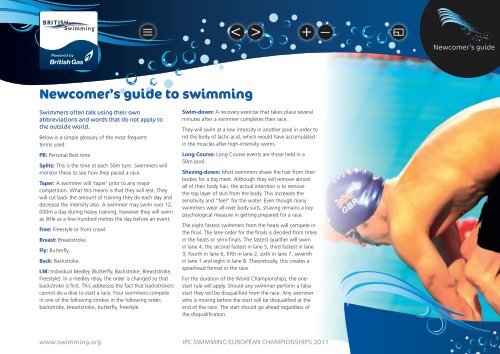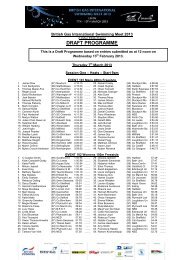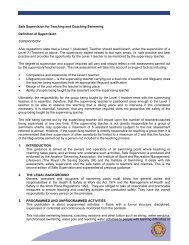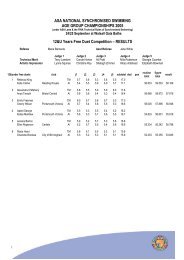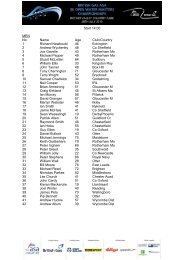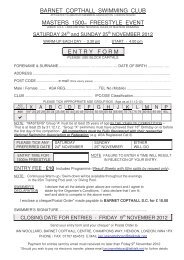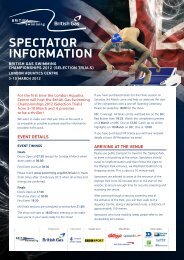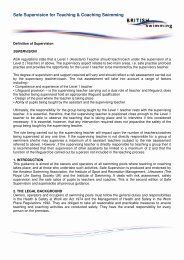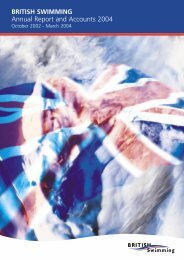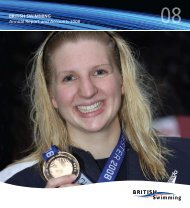ipc swimming european championships berlin 2011 - Swimming.Org
ipc swimming european championships berlin 2011 - Swimming.Org
ipc swimming european championships berlin 2011 - Swimming.Org
You also want an ePaper? Increase the reach of your titles
YUMPU automatically turns print PDFs into web optimized ePapers that Google loves.
Newcomer’s guide<br />
Newcomer’s guide to <strong>swimming</strong><br />
Swimmers often talk using their own<br />
abbreviations and words that do not apply to<br />
the outside world.<br />
Below is a simple glossary of the most frequent<br />
terms used:<br />
PB: Personal Best time<br />
Splits: This is the time at each 50m turn. Swimmers will<br />
monitor these to see how they paced a race.<br />
Taper: A swimmer will ‘taper’ prior to any major<br />
competition. What this means is that they will rest. They<br />
will cut back the amount of training they do each day and<br />
decrease the intensity also. A swimmer may swim over 12,<br />
000m a day during heavy training, however they will swim<br />
as little as a few hundred metres the day before an event.<br />
Free: Freestyle or front crawl.<br />
Breast: Breaststroke.<br />
Fly: Butterfly.<br />
Back: Backstroke.<br />
I.M: Individual Medley (Butterfly, Backstroke, Breaststroke,<br />
Freestyle). In a medley relay, the order is changed so that<br />
backstroke is first. This addresses the fact that backstrokers<br />
cannot do a dive to start a race. Four swimmers compete<br />
in one of the following strokes in the following order;<br />
backstroke, breaststroke, butterfly, freestyle.<br />
Swim-down: A recovery exercise that takes place several<br />
minutes after a swimmer completes their race.<br />
They will swim at a low intensity in another pool in order to<br />
rid the body of lactic acid, which would have accumulated<br />
in the muscles after high-intensity swims.<br />
Long Course: Long Course events are those held in a<br />
50m pool.<br />
Shaving-down: Most swimmers shave the hair from their<br />
bodies for a big meet. Although they will remove almost<br />
all of their body hair, the actual intention is to remove<br />
the top layer of skin from the body. This increases the<br />
sensitivity and “feel” for the water. Even though many<br />
swimmers wear all-over body suits, shaving remains a key<br />
psychological measure in getting prepared for a race.<br />
The eight fastest swimmers from the heats will compete in<br />
the final. The lane order for the finals is decided from times<br />
in the heats or semi-finals. The fastest qualifier will swim<br />
in lane 4, the second fastest in lane 5, third fastest in lane<br />
3, fourth in lane 6, fifth in lane 2, sixth in lane 7, seventh<br />
in lane 1 and eight in lane 8. Theoretically, this creates a<br />
spearhead format in the race.<br />
For the duration of the World Championships, the onestart<br />
rule will apply. Should any swimmer perform a false<br />
start they will be disqualified from the race. Any swimmer<br />
who is moving before the start will be disqualified at the<br />
end of the race. The start should go ahead regardless of<br />
the disqualification.<br />
www.<strong>swimming</strong>.org IPC SWIMMING EUROPEAN CHAMPIONSHIPS <strong>2011</strong>


